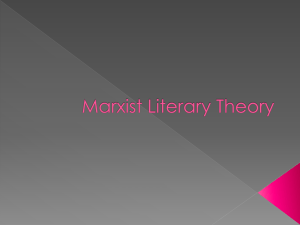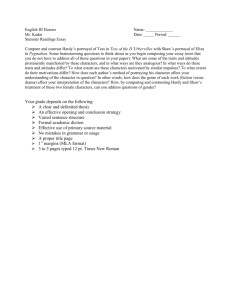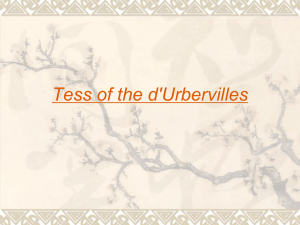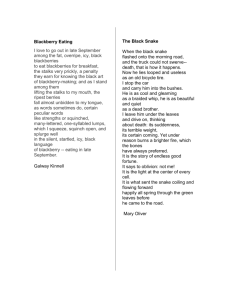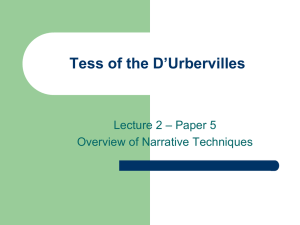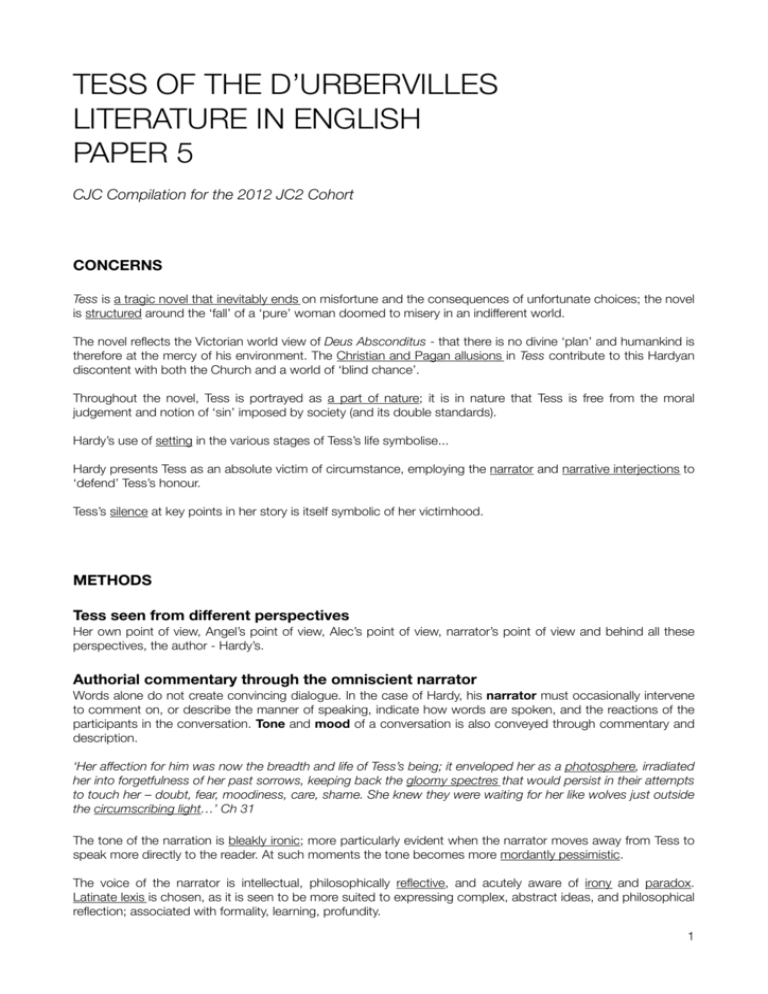
TESS OF THE D’URBERVILLES
LITERATURE IN ENGLISH
PAPER 5
CJC Compilation for the 2012 JC2 Cohort
CONCERNS
Tess is a tragic novel that inevitably ends on misfortune and the consequences of unfortunate choices; the novel
is structured around the ‘fall’ of a ‘pure’ woman doomed to misery in an indifferent world.
The novel reflects the Victorian world view of Deus Absconditus - that there is no divine ‘plan’ and humankind is
therefore at the mercy of his environment. The Christian and Pagan allusions in Tess contribute to this Hardyan
discontent with both the Church and a world of ‘blind chance’.
Throughout the novel, Tess is portrayed as a part of nature; it is in nature that Tess is free from the moral
judgement and notion of ‘sin’ imposed by society (and its double standards).
Hardy’s use of setting in the various stages of Tess’s life symbolise...
Hardy presents Tess as an absolute victim of circumstance, employing the narrator and narrative interjections to
‘defend’ Tess’s honour.
Tess’s silence at key points in her story is itself symbolic of her victimhood.
METHODS
Tess seen from different perspectives
Her own point of view, Angel’s point of view, Alec’s point of view, narrator’s point of view and behind all these
perspectives, the author - Hardy’s.
Authorial commentary through the omniscient narrator
Words alone do not create convincing dialogue. In the case of Hardy, his narrator must occasionally intervene
to comment on, or describe the manner of speaking, indicate how words are spoken, and the reactions of the
participants in the conversation. Tone and mood of a conversation is also conveyed through commentary and
description.
‘Her affection for him was now the breadth and life of Tess’s being; it enveloped her as a photosphere, irradiated
her into forgetfulness of her past sorrows, keeping back the gloomy spectres that would persist in their attempts
to touch her – doubt, fear, moodiness, care, shame. She knew they were waiting for her like wolves just outside
the circumscribing light…’ Ch 31
The tone of the narration is bleakly ironic; more particularly evident when the narrator moves away from Tess to
speak more directly to the reader. At such moments the tone becomes more mordantly pessimistic.
The voice of the narrator is intellectual, philosophically reflective, and acutely aware of irony and paradox.
Latinate lexis is chosen, as it is seen to be more suited to expressing complex, abstract ideas, and philosophical
reflection; associated with formality, learning, profundity.
1
Tess’s strikingly articulate and imaginative use of language
From the beginning, Tess speaks with a mastery of metaphor and symbol. The night drive with Abraham
shows her capacity to transform familiar objects, like apples, in cosmic figures of speech.Her early speeches are
first flowerings of her language, impelled by bitter intelligence. She even questions her faith, Christianity. Hardy
might have done better to let Tess speak more for herself…
But it can be argued, Hardy wants to provide space for his erudite third person narrator to use his larger
learning, to place and support the language of Tess’s mind even more formally, formidably, and forcefully.
‘Do you believe what you paint?’ she asked in low tones.
‘Believe that tex? Do I believe in my own existence!’
‘But’, said she tremulously, ‘suppose your sin was not of your own seeking?’
‘I leave their application to the hearts of the people who read ’em.’
‘I think they are horrible,’ said Tess. ‘Crushing! killing!’ (Ch 12)
‘How can I pray for you,’ she said, ‘when I am forbidden to believe that the great Power who moves the world
would alter His plans on my account?’
‘You really think that?’
‘Yes. I have been cured of the presumption of thinking otherwise.’ (Ch 46)
Setting and landscape
Setting and Landscape; have a literary purpose as Symbolism; each one provides the frame and background
for the stages of Tess’s life;
E.g. Flintcomb Ash is presented in an exceptionally explicit way— it symbolically suggests very potently the
sense of abandonment Tess feels.
The progressively more expansive size of the fields of each landscape creates the effect of reducing Tess in her
significance.
‘...set hacking in a stretch of a hundred odd acres’ 43
In Flintcomb Ash, the white lanes, the colourless atmosphere ‘field…in colour a desolate drab’; ‘the sky…a
white vacuity of countenance’ symbolically suggest the dryness and indifference of this landscape to Tess’s
abandonment; and plight in flight. We are echoically reminded of the indifference of the cosmos, as symbolically
suggested by the stars, described as ‘cold pulses’ and their ‘serene dissociation’ in Chapter 4.
To the stars, people have looked up to them as symbols of light and hope.
But on that same night, in a tragically ironical way, calamitous misfortune strikes…
This tragic incident shows Tess too has her flaws in the form of her predisposition for reverie and illusion;
Stereotypically gendered flaws? Which in any case, by symbolical extension, apply to the vast majority of
humanity, as most of human life is founded on illusion; Think even of the ‘appetite for joy’ and fanciful dreams of
Tess’s parents in Rolliver’s Inn: ‘the interval made… happy. A sort of halo, an occidental glow, came over life
then.’ [Chapter 3]
Symbolism
Shifting qualities and nuances of light and dark, sun and moon, are used to symbolically suggest the changing
nature of the Angel-Tess relationship and the changing balance of conflicts as their relationship develops…
For example, Angel’s idealization of the original Tess is symbolically suggested through ‘the spectral, halfcompounded, aqueous light’ in which ‘She looked ghostly, as if she were merely a ghost at large.‘ [Chapter 20]
‘She seemed to flinch…in too burning a sun.’ [Ch 27]
The final phase and the ending
Hardy’s narrator succeeds in conveying in those few pathetic end of days, a triumph as well as a defeat; so the
title of this phase of the novel is not wholly ironical. Tess peeps out to say: ‘All is trouble outside there; inside
2
here is content’; Her sense of release, and holiday, offers fulfillment through poetic imagination; She rests briefly
cocooned within her virtually finished story and inexorable history
Throughout the novel, we see Tess suffer; she seems to be doomed to suffer; She is destroyed by two men; you
could say three; And you could say, man, more generally, through man-made laws (via a morally corrupt
collusion of Church and State) which are as arbitrary as they are cruel; Her shame ‘based on nothing more
tangible than a sense of condemnation under an arbitrary law of society which had no foundation in Nature.’
Stonehenge: It is used to evoke uncertainty, and darkness. It is, after all, historically, a place shrouded in
obscurity and mystery. It therefore symbolically serves to represent an important counter to the kinds of rigid,
unyielding certainties, such as those once held by Angel Clare, As reflected earlier in that ‘hard logical
deposit’ [Chapter 36] that significantly contribute to Tess’s downfall. Tess, a sacrificial victim?
Recall Chapter 25: ‘Its transcendental aspirations’, ‘a zenithal paradise, a nadiral hell’;
‘the dreams of people’, ‘…he had seen only Life, felt only the great passionate pulse of existence, unwarped,
uncontorted, untrammeled by those creeds which futilely attempt to check what wisdom would be content to
regulate.’
Recall Chapter 36: ‘The dust and ashes of things, of the cruelty of lust and the fragility of love’ [Chapter 36]
‘Nature, in her fantastic trickery’ [Chapter 36]
Misfortune is a principle of cosmic forces in the universe, affecting the weak and the strong indiscriminately; no
holy plan in Nature; Social laws hang Tess; in Nature no such laws; But Nature itself turns against Tess;
‘This happiness could not have lasted’ [Chapter 58]
Fatalistic language in narrator’s commentary in Chapter 30
‘The ‘appetite for joy’ which pervades all creation, that tremendous force which sways humanity to its purpose,
as the tide sways the helpless weed, was not to be controlled by vague lucubrations over the social rubric.‘
[NB Diction: adjectives, verbs; Imagery, and effects]
‘Lucubration’: Laborious study or meditation especially when done at night
From the Latin ‘lucubratio’, study by night
Rubric: an authoritative rule esp for the conduct of church ceremonial
3
OUTLINE 1
How significantly do the issues of money and class figure in the role and characterisation of
Tess in the novel?
1. Relationship between money & class and identity
2. Tess’s role as tragic heroine; her dual nature which manifests itself in the duality of her roles: peasant /
aristocrat, daughter / guardian, pure woman / fallen woman, wife / mistress or lover, victim / survivor
3. Methods used by Hardy to present Tess as a character: eg. setting, use of names, imagery, symbolism,
dialogue, narrative techniques and perspectives, contrasts and parallels
Secondary question: to what degree do the questions of money and class drive plot development shape Tess’s
life and define Tess’s identity and roles?
1. Her self-perception, the way she perceives others, the way others perceive her
2. What other factors come into play? Gender stereotypes and expectations? Family? To what extent are
these factors influenced by money and class?
Secondary question: how do issues of class and money feature in the novel’s language and literary features?
1. Significance of class highlighted by the structure of the novel
- Importance of class identity foregrounded at the beginning of the novel by Parson Tringham’s revelation to
Jack Durbeyfield that he is descended from the “ancient and knightly family of the D’Urbervilles”, a family now
“extinct”.
- Hardy immediately conflates class identity with family history, setting the stage for the characterization of
Tess’s double lineage and the plot to subsequently “claim kin” with the Stoke-D’Urbervilles, after the death of
Prince.
- Within the frame of class identity and family history, the opening of the novel foreshadows the Durbeyfield’s
ongoing decline and seems to seal Tess’s tragic status.
2. Tess’s peasant class & her family’s deteriorating financial situation
- Her parents’ “shiftlessness”
- Corruptibility of the D’Urberville family name by money
- Circumstances that force Tess into the roles as daughter and guardian, culminating in her loss of virginal
innocence to Alec in The Chase.
- Key incidents: Prince’s death claiming kin with the D’Urberville family; the Durbeyfields’ eviction from their
cottage after John Durbeyfield’s death and her acceptance of Alec’s offer of financial help in return for her
becoming his mistress
- Hardy’s narrative methods: use of setting (the Durbeyfield cottage, the D’Urberville mansion at The Slopes,
Alec’s new villa at Sandbourne), use of dialogue (contrast between different types of diction), imagery /
symbolism (‘an enterprise… of such doubtful profit’, the Durbeyfield ‘ship’, etc)
- Class & money feature in the plot construction – Tess’s “enterprise” to reclaim aristocratic lineage ironically
results in her loss of individual identity, rendering her more dependent on the male characters.
3. Tess’s relationships with the Alec & Angel are determined by their class
differences and class biases
- Alec – sees her as a ‘farm girl’ with loose sexual morals. Power imbalance due to his wealth and her poverty.
- Key incidents: first meeting at Trantridge, the Chase scene, their meetings at Flintcomb Ash
4
- Angel sees her as an unsullied country maid, but wants to use her D’Urberville heritage to make their marriage
more acceptable to his family, and ironically, rejects her after her confession partly on the basis of this same
family lineage.
- Key incident: the garden scene, the confession scene
- Class relations as an extension of patriarchy that victimizes Tess
4. The relationship between Angel and Tess
- “ ‘If you were only to appear in a ball-room!’ he said. ‘But no- no, dearest; I think I love you best in the wingbonnet and cotton frock – yes, better than in this, well as you support these dignities.’” (Chap 34, p.221)
- “ ‘Different societies, different manners. You are an unapprehending peasant woman, who have never been
initiated into proportions of social things. You don’t know what you say.’” (Chap 35, p.232)
- “To produce Tess, fresh from the dairy, as a D’Urberville and a lady he had felt to be temerarious and risky;
hence he had concealed her lineage till such time as, familiarized with worldly ways by a few months’ travel
and reading with him, he could take her on a visit to his parents, and impart the knowledge while triumphantly
producing her as worthy of such an ancient line. [Note shift in perspective to that of the narrator: It was a pretty
lover’s dream, if no more. Perhaps Tess’s lineage had more value for himself than for anybody in the world
besides.]” (Chap 33, p.210)
5. The dual nature of Tess - she is both ‘peasant woman’ and descendent of an
aristocratic line
- Her double lineage also influences aspects of her character that contribute to her tragedy – the impulsiveness
is presented as being inherited from the D’Urbervilles, while her passiveness sees her taking after her parents
- Her pride that is inherited from the D’Urbervilles
- Her D’Urberville heritage is constantly emphasised: in the opening chapter through the parson’s
announcement, through setting (e.g. the farmhouse at Wellbridge that used to be a seat of the family), omens
and foreshadowing (the D’Urberville coach)
- Significance of social class expressed through family history, which is at the same time personal & sexual
histories.
6. The significance of class and money to Tess’s fate
- Tess’s potential for social mobility due to her education and her refined bearing
- “The dialect was on her tongue to some extent, despite the village school.” (Ch 2, p.15)
- Yet, at the same time this movement is marked by an essential homelessness as her identity cannot be
defined by any single class category.
- Symbolically represented in her movements between different locations throughout the novel
- Part of Tess’s tragedy lies in her unfulfilled potential for rising above the circumstances dictated by her class
and family background.
- Her inability to fit neatly into any one social class also renders her a permanent outsider, denying her any sense
of belonging even in her own family, and making her vulnerable to a series of tragic misinterpretations by the
men in her life.
- Yet, she rises to heroic stature in her endurance and essential purity (as Hardy presents her), in the face of
adversity and corruption.
- The difficulties caused by Tess’s economic hardships function as key turning points in the plot, pushing Tess
into roles that she does not want to assume (Alec’s latest fling, adulteress)
- However, these economic difficulties also present a context for Hardy to develop Tess’s role as a survivor
despite being a victim of circumstances beyond her control
- This contributes to her heroic status by allowing Hardy to endow her with strength and the ability to endure.
(esp. later in the novel at Flintcomb-Ash)
- Key scenes: the harvest scenes at Flintcomb Ash, Tess and the threshing machine
5
OUTLINE 2
Examine critically Hardy’s use of different settings in the presentation of relationships in the
novel.
-
Focus is not just on settings but different settings
What are the different settings in the novel?
How do the diff. settings relate to one another in Hardy’s construction of the novel? Effects & purpose?
Effects & Purpose – link to the presentation of relationships:
Tess’s relationship with the men (Alec & Angel), the women (e.g. other dairymaids), the community
Clarification of ‘setting’
- An impression of places in which char. are presented
- Scenes that are the background or situation for events in the novel
- Includes an impression of the social groups that char. are situated in (e.g. families, friends, customs &
practices of a particular social class)
- Atmosphere, mood or feel that is created in a particular place / scene
- Some general uses / functions of setting:
(i) To symbolise a character’s mood and his/her state of relations with other char. in a situation
(ii) To structure plot & relationships that unfold
(iii) To display an author’s views and judgements
Setting as structural device
- Hardy’s use of diff. settings serves to structure the phases of Tess’s life.
- Tess moves through the diff. settings, which mirror her development through relationships with others.
- The diff. settings also structure the pattern of contrasts & parallels in the web of relationships constructed in
the novel:
1. Industrial / Urban landscapes
2. The railway-station from which milk is transported to London (Ch.30, p.186-187)
3. Towns – Kingsbere, “the half-dead townlet” where lay the ancestors of the D’Urbervilles (Ch.52, p.361-362)
& Sandbourne, whose modernity is unreal (i.e. a “fashionable” “fairy place” – Ch.55, p.375-376)
4. City of Wintoncester (Ch.59)
5. Natural landscapes:
Valleys & plateau - Blackmore Vale & the Valley of the Fromme (Ch.16), with Flintcomb-Ash (Ch.43) situated at
the plateau in-btwn
Woods & forests – The Chase (Ch.11) & the New Forest (Ch.57)
Gardens & farms – the fruit garden at The Slopes (Ch.5) vs. the uncultivated garden at Talbothays (Ch.19);
idyllic dairy-farm at Talbothays vs. “starve-acre” Flintcomb-Ash farm
Male / female relationships
Hardy uses different settings to structure the contrast in Tess’s relationship with Alec & Angel.
The ancient woods of the Chase as the setting for Alec’s sexual violation of Tess
Tess as a prey chased and hunted down by Alec
The fading of moonlight & the enveloping mist/fog evoke a mysteriously still but sinister atmosphere of
“blackness” that threatens the pure “white muslin figure” of Tess “left upon the dead leaves”.
- The pervasive fog in darkness obscures the sexual act, making it ambiguous if Tess was raped or seduced.
- Contrast with the lush fertility Talbothays as the setting for the budding romance & courtship btwn Angel &
Tess
- As they walk through the open mead during the twilight of morning and evening, there is also the ethereal
presence of mist / fog but with a more nuanced interplay of light and dark in the setting presented.
-
6
- “The spectral, half-compounded, aqueous light which pervaded the open mead, impressed them with a
feeling of isolation, as if they were Adam and Eve.”
- “Whilst all the landscape was in neutral shade his companion’s face, which was the focus of his eyes, rising
above the mist stratum, seemed to have a sort of phosphorescence upon it. She looked ghostly, as if she
were merely a soul at large.” (Ch.20, p.130)
Female / female relationships
- Friendship btwn Tess & her other dairymaids tested & strengthened in places of suffering
- The arid and “starve-acre” place of Flintcomb-Ash Farm reflects the disappointment of Tess as a deserted
wife.
- Hellish images of machines at the farm emphasise (male) mechanical exploitation of feminine labour.
- But the harsh indifferent environment (see Ch.43, p.285) also serves to unite Tess & Marian in their suffering at
work & in love
Tess and the community
-
Landscapes of community, apart from landscapes of desire
Tess’s journey through different landscapes of community only serves to emphasise her isolation.
The temporary nature of these communities accentuates her homelessness.
The Marlott community does not offer Tess any real permanent support and her inhabitants move on.
The community at Flintcomb-Ash is made up of ghosts from the past, leaving Tess undefended against Alec.
(Note recurring images of trapped animals)
Even in the most idealised community at Talbothays, Tess is isolated by the shame of her sexual past which
makes her feel unworthy of Clare’s affections for her.
Setting also includes the cycle of seasons that generates the novel’s structure & pattern of imagery in the
presentation of relationships.
Novel opens in high spring in May, where girls are in bud, anticipating future courtship & marriage.
The passion btwn Tess & Angel at Talbothays takes place at the height of summer into a long autumn, where
images of fertility and heat abound.
Tess & Angel’s wedding on New Year’s Eve, in the depths of winter
Wintry aspects of Flintcomb-Ash that mirrors the inner desolation of Tess as deserted wife – note the
description of the Arctic birds (“gaunt spectral creatures with tragical eyes”) and their symbolic significance
(Ch.43, p.288)
7
WRITING A THESIS / INTRODUCTION
To what extent is Tess differentiated from stereotypes of the feminine?
Outline the key methods for yourself to ‘keep track’
I believe Tess is differentiated from stereotypes of the feminine to a small extent especially
when we first encounter her as a character, but this extent increases significantly in the
course of the plot relative to her situated ‘self’ in the context of the novel’s intentions. To
demonstrate this, I shall in this regard analytically focus on the novel’s various literary and
linguistic modes of her representation (via the male voice of the omniscient narrator’s
philosophical commentaries and narrated descriptions pertaining to her thoughts and
actions, as well as the choice and form of her voiced direct and indirect speech) as a female
character in her own right; in terms of her physical portrayal; her psychological portrayal; her
relationships with other female characters, and her relationships with male characters, most
especially Alec and Angel, and the natural world.
Your thesis should centre on the purpose and concerns of the text
Tess is in many ways a puzzle. Her representation is full of puzzling ambiguities. She is
presented as an individual, yet does not appear to have much of an inner life. Though an
individual, she is also very much associated with Nature, and Hardy strongly emphasises this
through the use of imagery and symbolism. Does this then mean her representation is
typically feminine? I shall argue not so as this is essential to the novel’s larger concerns. Most
fundamentally, to be intentionally associated with Nature and united to Nature is to place Tess
on a higher plain to the surrounding artificially elevated sham patriarchal moralism that crudely
and prudely condemns her. We are thus compelled to sympathise with her as glorious victim,
and shun her hypocritical, inglorious victors—not a real victory.
8
PRELIM QUESTION A
‘Tess’s tragic flaw is her sexual nature.’ How far do you agree?
Tess’s sexuality has been a source of contention for critics since the novel’s publication. While Hardy
defends her even in the subtitle, asserting that she is “a Pure Woman Faithfully Represented”, others,
such as critic Mowbray Morris, derided the text for possessing “rather too much succulence”,
although whether he refers to the character proper or rather to Hardy’s prurient interest is unclear.
While I must ultimately agree1 that Tess’s sexual nature is the the greatest source of her troubles and
her eventual execution, Hardy transcends mere voyeurism: by contrasting2 her victimisation by the
male gaze with the profoundly natural, normal way her sexuailty is asserted, he instead turns the
circumstances of her death into a satire of Victorian hypocrisy3.
Notes:
1) answers directly, but expands it: introduction provides overview of entire argument and structure of the essay.
2) refers explicitly to technique: juxtaposition and contrast.
3) addresses the themes of the paper: hypocrisy and sexual double-standard.
Morris falls into the same trap that the pseudo-antagonists Alec and Angel do: he assumes that her
physical lushness is indicative of a lustful nature. It must be noted, however, that despite the allure
with which Tess is presented, her true image is refracted through the gazes of various men, whose
fixation with her beauty ultimately serves as a commentary not on the temptations of women but
rather on male lasciviousness. The narrator himself, when describing Tess, adopts a moderate, cool
tone: Tess’s impressive inherited assets from her mother’s side are described by the playfullyeuphemistic “bouncing handsome womanliness”, which manages to be coy and utterly transparent at
the same time. Tess in absolute terms is “a picturesque country girl, nothing more”, and it is only in
the eyes of her admirers that her beauty acquires a cutting edge.
Although Alec and Angel are initially represented as polar opposites, the two men who woo and ruin
Tess demonstrate a disturbing congruence in their proclivities. Alec is the typical Victorian rake,
representative of “the danger in men-folk”: his “swarthy complexion” and “touches of barbarism” in his
features foreshadow his lack of restraint and moral rectitude, while his physiognomy, his “full lips... red
and smooth”, hint at a lascivious and indulgent nature. His interest in Tess’s “luxuriance of growth,
upon which his eyes “rivet” themselves, is unsurprising, at least to us: the metaphorical bolting of his
eyes to her bosom is both cartoonish and sinister, combining inexorable force with a hyperbolic level
of penetration, as if his eyes not only focus on her bosom but attempt to pierce beneath it. It is
interesting, however, that at this point we experience one of Hardy’s narrative interjections, as the
narrator intervenes to reassure us of Tess’s objective and absolute innocence. She is, in the same
paragraph, described as being “innocent”.
Angel, on the other hand, we are supposed to expect more from, and his growing fascination with her
beauty becomes even more ominous than Alec’s, because of his initial presentation as someone who
loves Tess for “her soul, her heart, her substance”. Even the image of his “affection itself” being “less
fire than radiance” contribute to the idea of Angel the intellectual, Platonic lover, whose Romantic
passion for Tess as a goddess (he refers to her, with oblivious irony, as ‘Artemis’, the virgin goddess of
the hunt) transubstantiates the baser, sultry heat of Alec’s lust into divine, insubstantial light. It is
revealed, however, that Angel’s attraction to Tess is if anything just as physical as Alec’s. Both men
profess a fascination for her “mobile peony mouth”, that in its redness and shape stand in for the
female genitals. Angel is obsessed with “her mouth”, compared to which “he had seen nothing to
equal on the face of the earth”, and his fetish is echoed by Alec. Both of them describe her mouth in
the same terms evoking the idea of mania, lost restraint, irrationality: to Angel her mouth is
“distracting, infatuating, maddening”. When Alec exclaims that “there never was such a maddening
mouth since Eve’s!” his voice is indistinguishable from Angel’s, who sees “the red interior of her mouth
as if it had been a snake’s”.
9
It is therefore clear, when we compare the more objective narrative rendering of Tess’s appearance
with the swains’ obsessive fetishisation of her physical beauty, that while Tess’s sexual attractiveness
is a source of distraction and temptation for them, it is they who are projecting their own sexual urges
onto Tess, using the language of a misogynistic, patriarchal Church to compare her to Eve and the
serpent in one.
Tess is, of course, not entirely asexual, but Hardy’s depiction of her sexual awakening and expression
is one that absolves her of sin rather than one that condemns her. While Tess might have conceived of
her love for Angel as having “hardly a touch of earth”, her behaviour suggests otherwise. Her jealousy
of the other girls culminates in a paroxysm not unlike that of intense arousal, as she “jealousy
panted... with her hot face in the pillow”, when she overrides her earlier reservation and decides to
marry Angel after all. In her own innocence Tess might not have suspected herself of desiring Angel,
but her own words, that she “can’t bear to let anyone else have him”, employ the concept of
possession and acquisition (‘having’ Angel) familiar to the men. Her desire, however, is not distorted
by puritanical hypocrisy. Angel, quick to absolve himself of the brand of fornication, confesses his
sexual indiscretion to Tess as him being “tossed about by doubts and difficulties”, playing the victim
by claiming to have been helpless “like a cork on the waves”. His attempts to justify his sexuality are
an alien thing to him, a manmade artifact dwarfed by the immensity of nature.
In contrast, Tess’s true sexual nature, her desire for Angel, arises from “cruel Nature’s law”, brought on
inevitably by the heat of summer and her own growing maturity. At Talbothays, Nature itself erupts in
an exuberant chorus of fecundity, where the “rays... draw forth the buds, and (stretch) them into long
stalks”. The description of summer’s waxing at Talbothays is incredibly dense with sexually-rife
imagery, an explosion of phallic and yonic shapes drenched in sun-quickened sap: the proud erection
of the “long stalks” is paired with “opened petals”, and the whole affair is doused with liberal lashings
of “streams” of “sap”. Confronted by such an inexorable force, Tess’s desire for Angel and her
competition with the other girls for his favour ironically grants her the precise pastoral innocence that
Angel so zealously seeks in nature.
Hardy’s decision, daring for the period, to represent Tess’s sexual nature as an at its root utterly
natural, inevitable, and irreproachable phenomenon, defies any interpretation of that nature having led
her to her downfall. For that, we must look to those who have sought to defy rather than heed their
own natures: the blame for Tess’s rape, her abandonment, and exploitation that culminate in her
death must be laid at the feet of the hypocrites who fetishise her.
Mr. Nigel Na
10
PRELIM QUESTION B
Discuss the ways in which symbols and images contribute to the novel as a moral
protest against the prevailing conventions of Victorian society.
Background
Symbols, Images and Moral Protest in Tess
Literary Symbolism: When something literal suggestively takes on added significance; when some object, event,
action, setting, detail is suggestively intended to mean something more than just what it means in ordinary, literal
terms;
In the novel ‘Tess’, — the sun, the moon, fog, fire, spring, summer, winter, the natural landscapes of the novel
such as Talbothays Dairy Farm and Flintcomb Ash, and actions such as Tess’s repeated silences re- the night of
the Chase — all of these suggestively function to take on meanings beyond their merely literal meanings. Many
of the realistic descriptions provided by Hardy’s narrator are symbolically suggestive. And so such descriptive
passages of the landscapes should not be read in a purely literal manner, as they are intended to suggestively
mean something more than their mere literal meaning. Indeed there may well be as in many instances a plurality
of symbolically suggested meanings. For example, the narrator’s sensuous descriptions of actions and
landscapes in Talbothays are symbolically suggestive of human love and sexual passion (More about that later).
Imagery in Tess
The patterned network of Imagery of fauna (such as birds, rabbits, and cats), and flora (roses and strawberries,
Tess’s mouth flower-like, her breadth compared to the tastes ‘of the butter and eggs and honey on which she
mainly lived’ ch 36; she is also compared to a ‘plant’ and a ‘sapling’);
Intended effect of all these images: to encourage us as readers to see and think i.e. mentally associate Tess as
being essentially in touch with Nature. Much of her character is presented through and defined by natural
imagery, imagery associating her with nature.
Notice the great frequent use of imagery in the form of the simile (direct comparison through ‘like’ or ‘as’), that is
used simply, or developed through extended elaboration; notably the many occasions Tess is directly compared
with wild animals and birds of the British countryside to highlight and reinforce her naturalness, and the
naturalness of her feelings and desires. The simile comparing Tess to a cat (‘She went stealthily as a cat’ ch 19)
is intended to show how much she is at ease with her natural surroundings, and by presenting her from this
angle of vision the narrator wants to subtly imply that she is not at ease in Victorian society.
The metaphor of the Hunt functions as an extended metaphor, as it is repeated very frequently; where Tess’s
total movements can be said to form a single metaphor of being hunted like an animal. It begins proper on the
night of the Chase and ends on Stonehenge; and her ultimate execution the action of which is not to be merely
read literally but is also intended to symbolically suggest that Tess through her hanging is being condemned for
transgressing the moral boundaries of Victorian society. Of course we as readers are meant to feel deep sorrow
for Tess and moral outrage towards her society.
Discussion
In discussing the novel as a moral protest against Victorian moral conventions, this question requires one to
analytically engage with Hardy’s very extensive and highly patterned manipulation of figurative language (Imagery
and Symbolism) throughout the course of the novel. What follows are suggested ways through which an essay
answer to this question could be developed.
Unpacking the sense of the Question:
Victorian society’s prevailing conventions / standards pertaining to sexual morality codes of conduct governing
women; such as the moral and religious conservative requirement for a woman to be and remain pure (chaste)
11
before entering the marriage state; and Victorian society’s double standards, as this did not apply to men who
transgressed moral boundaries governing sexual conduct between the sexes prior to marriage, and thereafter;
The novel makes a claim for equality between men and women in sexual matters; it is clearly intended that the
reader be shocked and outraged when Angel Clare admits his own prior sexual misconduct but refuses to see
that Tess’s case is similar to his, and instead Angel proceeds to condemn her.
Also the novel serves as a protest against the kind of negative, harsh disregard, unkind disrespect to which
children born out of wedlock were subjected to as surfaced in the very symbolically suggestive name of Tess’s
child, ‘Sorrow’ and as made further apparent through the narrative details describing the child’s baptism and
burial.
The novel could be said to be a critique of the whole Victorian discourse of purity.
The colour red motif that runs through the entire novel beginning with the red ribbon and white company
antithesis in Chapter 2; the colour ‘red’ connotes sexual passion and sexual rebellion, hence the sense of
protest; white – purity.
For example, ‘she became splashed from face to skirt with the crimson drops’ Chapter 4 p33
The symbolical significance of Tess’s repeated ‘Silences’; the narrator subtly makes it evident to the reader the
three times elisions of Tess’s own personal account of what actually happened on the night of The Chase.
Contextualized to the demands of this question, the fact that the reader does not get to ever hear Tess speak
directly to us in her own voice on what actually happened, symbolically suggests the unspeakability of this
event. The loss of her chastity prior to / outside the bonds of a Christian marriage (however natural) is perceived
as shameful in the eyes of Victorian society, though unwarranted from the point of view of the narrator. And
hence, the silence subtly implies a form of protest. Also this coupled with the narrator’s own ambiguous
representation of events (seduction or rape?) reinforces in symbolical terms the extent to which a sexually
passionate girl like Tess would have felt compelled to curtail any degree of free and open exposition and
expression because of the strict censure, oppression and repression of Victorian style morality especially as it
applied to women.
Literary critic, David Lodge, argues that the force of the connection between Tess and the natural world is
intended to symbolically suggest the mad, passionate, non-ethical quality of her sensibility (‘This profusion of
growth…made blood-red stains on her skin’ p122-123). This dimension of her character makes her life a
peculiarly vulnerable one. It lays open her seduction by Alec D’Urberville. [For Lodge] it is important for the
reader to come to realize that Tess is seduced on the night of the Chase, not raped. Thus if the ‘Chase’ scene is
interpreted in this way, it makes these elisions, these silences of Tess, all the more significantly relevant where
the central issues of this question are concerned.
Metaphors such as the “bird caught in a trap” metaphor can be related to the extended hunt metaphor;
contextualized to the demands of this exam question, images of Tess whereby she is indirectly likened to
entrapped / ensnared animals is suggestive of how constraining, constricting, and ‘life-and-soul’ destroying it
was for a woman to have to live in and abide by the moral and social codes of Victorian society.
Tess is presented as innocent / pure in the eyes of Nature; but impure / unchaste in the eyes of Victorian
society; Tess’s purity is made apparent to the reader through symbolical analogies with elements of the natural
landscape. See the following passage:
‘[But] this encompassment of her own characterization, based on shreds of convention, peopled by phantoms
and voices antipathetic to her, was a sorry and mistaken creation of Tess’s fancy – a cloud of moral hobgoblins
by which she was terrified without reason. It was they that were out of harmony with the actual world, not she.
Walking among the sleeping birds in the hedges, watching the skipping rabbits on a moonlit warren, or standing
under a pheasant-laden bough, she looked upon herself as a figure of Guilt intruding into the haunts of
Innocence. But all the while she was making a distinction where there was no difference. Feeling herself in
antagonism she was quite in accord. She had been made to break a necessary social law, but no law known to
the environment in which she fancied herself such an anomaly. [Ch 13 p85-86]
You would need to note and comment analytically on the characteristic use of bird imagery. Also the symbolical
significance of the descriptions of Nature, with Tess as Eve and Angel as Adam in the ‘Edenic’ like Talbothays
Dairy Farm, and the novel’s strongly evident celebration of the pleasure principle as central to life, which would
12
be contrary to the tenets of Christian morality which emphasized the idea that to lead the good life was to lead a
life of virtue, and practice of self-denial, the denial of the pursuit of pleasure including sexual pleasure.
‘The irresistible, universal tendency to find sweet pleasure somewhere, which pervades all life,
from the meanest to the highest, had at length mastered Tess.’ [Ch 16 p103]
Such a hedonistic principle would not have been condoned by the established church. To see life as the pursuit
of pleasure was seen to be morally at odds with church teachings and was thus perceived as tantamount to
courting a life of moral profligacy.
A key passage Ch 16 p104
‘And probably the half-unconscious rhapsody was a Fetishistic utterance in a Monotheistic falsetto; women
whose chief companions are the forms and forces of outdoor Nature retain in their souls far more of the Pagan
fantasy of their remote forefathers than of systemized religion taught their race at later date.’
The symbolism of Nature in the various nature scenes of the novel, more especially in Phase the Third, through
the combined symbolically suggested action of landscape, farmland, agriculture, weather and season; such a
life is deemed more desirable being more naturally free, and untouched and untrammeled by ‘systemized’
Victorian culture and civilization;
Note too in this regard the description of the cows in Talbothays at the end of ch 16:
‘Their large-veined udders hung ponderous as sandbags, the teats sticking out like the legs of a gipsy’s crock;
and as each animal lingered for her turn to arrive the milk oozed forth and fell in drops to the ground.’
The “germination” of a new springtime “was almost audible in the buds: it moved her as it moved the wild
animals, and made her passionate with joy.”
Here the narrator places Tess’s ‘Rally’, the recovery in the context of animal life and ‘wild’ Nature, of bud growth
and animal excitation.
All this description symbolically sets the stage for sexual love developing in wild, unconstrained Nature. The love
of Tess as “a genuine daughter of Nature”, a daughter of the soil, and her Angel Clare. Nature is presented so
that it can be perceived as being sexual and human beings are a part of nature.
The scene presenting the three milkmaids in Nature among the cows:
‘All the girls drew onward to the spot where the cows were grazing in the farther mead,
the bevy advancing with the bold grace of wild animals—the reckless unchastened motion of women
accustomed to unlimited space—in which they abandoned themselves to the air as a swimmer to the wave. It
seemed natural enough to [Angel] now that Tess was again in sight, to choose a mate from unconstrained
Nature, and not from the abodes of Art.’
Note again the natural (animal) imagery. Here we have the narrator’s perspective, as well as Angel’s. The image
presented is meant to function as the desired antithesis of Victorian civilization’s repressive Christian femininity.
A central and recurrent motif is that of the Fall which again is surely meant to protest against the Victorian
archetype of the fallen woman following the ambiguous rape / seduction scene.
Towards the end, Stonehenge and its connected associations with what the narrator earlier describes in ch 16
as ‘a Fetishistic utterance in a Monotheistic falsetto…’ symbolically functions as the antagonistic antithesis of an
oppressive, ‘systematized religion taught their race at later date.’
Note by way of concluding remarks:
Lines of argument proceeding on the basis of the foregoing critical and stylistic considerations and explorations
of the text suitably set out and arranged in a structurally coherent manner, and suitably and substantially
elaborated through close reference to relevant portions and quotations from the text, and analytical engagement
with form (narrative method and elements of style pertaining especially to imagery and symbolism), in relation to
plot and plot structure (phasal awareness) would have ensured for the student doing this question an excellent
grade. Finally, to answer any question on Hardy’s ‘Tess’ will inevitably require the student to insightfully and
analytically engage with narrative technique and elements of style, including his use symbolism and imagery.
13

